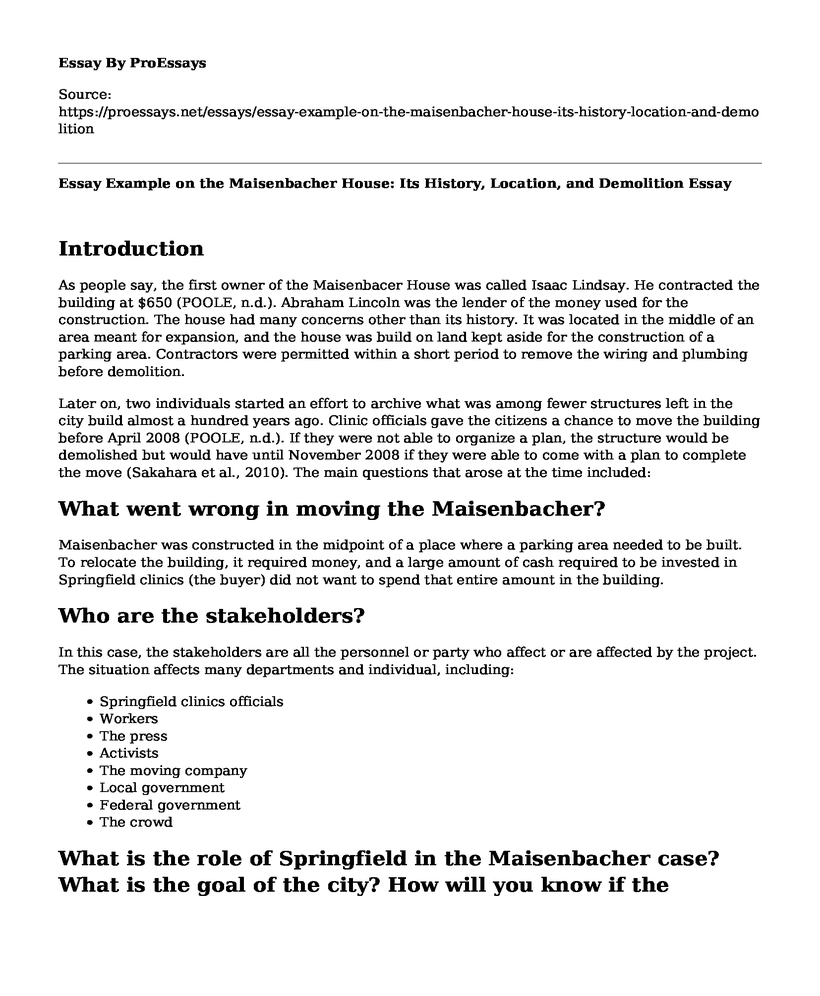Introduction
As people say, the first owner of the Maisenbacer House was called Isaac Lindsay. He contracted the building at $650 (POOLE, n.d.). Abraham Lincoln was the lender of the money used for the construction. The house had many concerns other than its history. It was located in the middle of an area meant for expansion, and the house was build on land kept aside for the construction of a parking area. Contractors were permitted within a short period to remove the wiring and plumbing before demolition.
Later on, two individuals started an effort to archive what was among fewer structures left in the city build almost a hundred years ago. Clinic officials gave the citizens a chance to move the building before April 2008 (POOLE, n.d.). If they were not able to organize a plan, the structure would be demolished but would have until November 2008 if they were able to come with a plan to complete the move (Sakahara et al., 2010). The main questions that arose at the time included:
What went wrong in moving the Maisenbacher?
Maisenbacher was constructed in the midpoint of a place where a parking area needed to be built. To relocate the building, it required money, and a large amount of cash required to be invested in Springfield clinics (the buyer) did not want to spend that entire amount in the building.
Who are the stakeholders?
In this case, the stakeholders are all the personnel or party who affect or are affected by the project. The situation affects many departments and individual, including:
- Springfield clinics officials
- Workers
- The press
- Activists
- The moving company
- Local government
- Federal government
- The crowd
What is the role of Springfield in the Maisenbacher case? What is the goal of the city? How will you know if the government is effective?
Springfield had the idea of applying their plan. They wanted to demolish the building and issued the activists a time frame to move the construction if they were able to. At the same time, the city required to acquire more federal money to cater for the cost of running the house, and that was possible when they learned an amount of $ 280,000 to cover for all the expenses that could be inquired.
From the perspective of a city manager, what complexities are inherent in the case? In what ways might the environment shape the public manager's job in this case?
There are two main ecological aspects determined by the action. The first is Economical, preserving the tradition of this precious construction will need considerable funding and efforts from the federal government and the state. The other aspect is Political, activists and the media's purpose, in this case, may add the tension on the manager of the city and make the circumstances difficult amidst the city officials and the buyer.
What competencies would best prepare a public manager to be effective in the Maisenbacher case?
They were using the media to conduct interviews to talk about the ways possible to cut cost and acquire the best outcomes on how best to act on the affair mainly if the other stakeholders from the federal and state rank come to the hearing. The people and other groups with interests will join in to compromise the differences.
The stakeholders, in this case, did an excellent work to safeguard the national treasure. The state had the responsibility to fund the movement and was helpful when the time came to support the activity. National treasures are essential to be kept safe as they remind of the past days (Koschtial, 2008). They also act as tourist attractions; hence, they are a boost to the economy.
I feel encouraged by the effort each individual and organization put to keep the building standing. The building will help in teaching the younger generation about the past. That is possible since they have proof to relate with.
References
Koschtial, U. (2008). The 2001 UNESCO Convention on the Protection of the Underwater Cultural Heritage: advantages and challenges. Museum international, 60(4), 63-69.
POOLE, D. (n.d.). Maisenbacher House move set to start. The State Journal-Register. https://www.sj-r.com/article/20081112/NEWS/311129885
Sakahara, S., Xie, Z., Koike, K., Hoshino, S., Sakata, I., Oda, S. I., ... & Sakai, T. (2010). Physiological characteristics of gastric contractions and circadian gastric motility in the free-moving conscious house musk shrew (Suncus murinus). American Journal of Physiology-Regulatory, Integrative and Comparative Physiology, 299(4), R1106-R1113.
Cite this page
Essay Example on the Maisenbacher House: Its History, Location, and Demolition. (2023, Apr 24). Retrieved from https://proessays.net/essays/essay-example-on-the-maisenbacher-house-its-history-location-and-demolition
If you are the original author of this essay and no longer wish to have it published on the ProEssays website, please click below to request its removal:
- Disproportionate Minority Contact Policy Essay Example
- Principles on Fleet Management Paper Example
- Research Paper on Real Estate: Luxury & High-Income Generating Industry
- Find Optimal Routes for Vehicles: Big Data Analytic Approach - Essay Sample
- How to Change a Tire: A Step-by-Step Guide - Essay Sample
- Essay Example on Probation Officers: Managing Crime and Punishment
- Essay Example on Police Use of Force: 3 Perspectives on a Complex Issue







